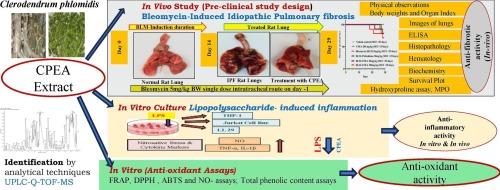全株雪梨乙酸乙酯提取物对博来霉素(BLM)诱导的大鼠特发性肺纤维化(IPF)的改善作用:体外和体内研究
IF 4.7
2区 医学
Q2 IMMUNOLOGY
引用次数: 0
摘要
特发性肺纤维化(IPF)是一种常见的慢性肺部疾病,病因不明,以纤维化和炎症为特征。在特发性肺纤维化(IPF)中,由于细胞因子和免疫细胞促进炎症和纤维化,肺瘢痕形成进展。从印度植物“agnimantha”中提取的Clerodendrum phlomidis (CPEA)的乙酸乙酯提取物具有抗炎和抗纤维化的特性,在传统的阿育吠陀医学中得到认可。本研究调查了以前未被研究过的phlomidis (CPEA)的潜在保护机制,并展示了CPEA如何影响博来霉素(BLM)诱导的肺纤维化。采用UPLC-ESI-Q/TOF-MS技术对黑石斛进行植物代谢组学分析。通过ABTS、DPPH、FRAP和NO测定自由基清除能力来评估植物的抗氧化能力。通过ELISA和Griess试剂检测,我们评估了CPEA对lps诱导的Jurkat、THP-1和LL-29细胞系的抗炎作用。本研究比较了气管内注射blm诱导Wistar大鼠IPF与口服CPEA提取物的抗纤维化和抗炎作用。采用多种技术,包括酶联免疫吸附试验(ELISA)、羟脯氨酸、组织病理学、生化、抗氧化酶谱分析和血液学分析。多酚类化合物用定性CPEA进行鉴定。植物提取物在体外表现出清除自由基和抗氧化的活性。CPEA提取物降低lps刺激的Jurkat、THP-1和LL-29细胞中TNF-α、IL-1β和NO水平。在blm诱导的Wistar大鼠肺和血清条件下,CPEA提取物显著降低(p本文章由计算机程序翻译,如有差异,请以英文原文为准。

Effect of ethyl acetate extract of the whole plant Clerodendrum phlomidis on improving bleomycin (BLM)-induced idiopathic pulmonary fibrosis (IPF) in Rats: In vitro and in vivo research
Idiopathic pulmonary fibrosis (IPF) is a prevalent chronic lung condition of unknown etiology characterized by fibrosis and inflammation. Lung scarring progresses owing to cytokines and immune cells that promote inflammation and fibrosis in idiopathic pulmonary fibrosis (IPF). The anti-inflammatory and anti-fibrotic properties of the ethyl acetate extract of Clerodendrum phlomidis (CPEA), derived from the Indian plant “agnimantha,” are recognized in traditional Ayurvedic medicine. This study investigated the potential protective mechanisms of Clerodendrum phlomidis (CPEA), which have not been previously examined, and demonstrated how CPEA affects bleomycin (BLM)-induced lung fibrosis. Phytometabolomic analysis of Clerodendrum phlomidis was performed using UPLC-ESI-Q/TOF-MS. Free radical scavenging assays were also used to evaluate the antioxidant capacity of the plants using ABTS, DPPH, FRAP, and NO assays. Using ELISA and Griess reagent assays, we assessed the anti-inflammatory effects of CPEA in LPS-induced Jurkat, THP-1, and LL-29 cell lines. This study compared intratracheal injection of BLM-induced IPF in Wistar rats with oral administration of CPEA extract for its anti-fibrotic and anti-inflammatory properties. Multiple techniques were employed, including enzyme-linked immunosorbent assay (ELISA), hydroxyproline, histopathological, biochemical, antioxidant enzyme profiling, and hematological analyses. Polyphenolic compounds were identified using qualitative CPEA. Plant extracts demonstrated free radical-scavenging activity in vitro and exhibited antioxidant properties. CPEA extract reduced TNF-α, IL-1β, and NO levels in LPS-stimulated Jurkat, THP-1, and LL-29 cells. In response to BLM-induced lung and serum conditions in Wistar rats, the CPEA extract significantly reduced (p < 0.05) markers of inflammation and fibrosis (ALP, LDH, TNF-α, CXCL8-MIP2, MMP7, SP-A, SP-D, NO, TBARS, and MPO) and significantly restored antioxidant enzymes (p < 0.05) (GSH, GPx, and GST) and anti-inflammatory cytokines (IL10). Oral CPEA extract attenuates fibrosis, inflammation, oxidative stress, nitrosative stress, and lipid peroxidation in BLM-induced idiopathic pulmonary fibrosis (IPF). CPEA extract improved lung function and increased survival rates. Clinical trials are necessary, as this study indicated that the dietary flavonoid-rich component of CPEA extracts possesses anti-inflammatory and antioxidant properties. CPEA extract restored antioxidant enzyme levels and exerted anti-fibrotic and anti-inflammatory effects in rats with idiopathic lung fibrosis induced by BLM. CPEAs protect against lipopolysaccharide (LPS)-induced inflammation in vitro and bleomycin-induced idiopathic pulmonary fibrosis (IPF) in vivo. The findings of our investigation indicate that CPEA demonstrates therapeutic potential for IPF in human subjects, as evidenced by its capacity to enhance antioxidant, anti-inflammatory, and anti-fibrotic markers in preclinical disease models.
求助全文
通过发布文献求助,成功后即可免费获取论文全文。
去求助
来源期刊
CiteScore
8.40
自引率
3.60%
发文量
935
审稿时长
53 days
期刊介绍:
International Immunopharmacology is the primary vehicle for the publication of original research papers pertinent to the overlapping areas of immunology, pharmacology, cytokine biology, immunotherapy, immunopathology and immunotoxicology. Review articles that encompass these subjects are also welcome.
The subject material appropriate for submission includes:
• Clinical studies employing immunotherapy of any type including the use of: bacterial and chemical agents; thymic hormones, interferon, lymphokines, etc., in transplantation and diseases such as cancer, immunodeficiency, chronic infection and allergic, inflammatory or autoimmune disorders.
• Studies on the mechanisms of action of these agents for specific parameters of immune competence as well as the overall clinical state.
• Pre-clinical animal studies and in vitro studies on mechanisms of action with immunopotentiators, immunomodulators, immunoadjuvants and other pharmacological agents active on cells participating in immune or allergic responses.
• Pharmacological compounds, microbial products and toxicological agents that affect the lymphoid system, and their mechanisms of action.
• Agents that activate genes or modify transcription and translation within the immune response.
• Substances activated, generated, or released through immunologic or related pathways that are pharmacologically active.
• Production, function and regulation of cytokines and their receptors.
• Classical pharmacological studies on the effects of chemokines and bioactive factors released during immunological reactions.

 求助内容:
求助内容: 应助结果提醒方式:
应助结果提醒方式:


